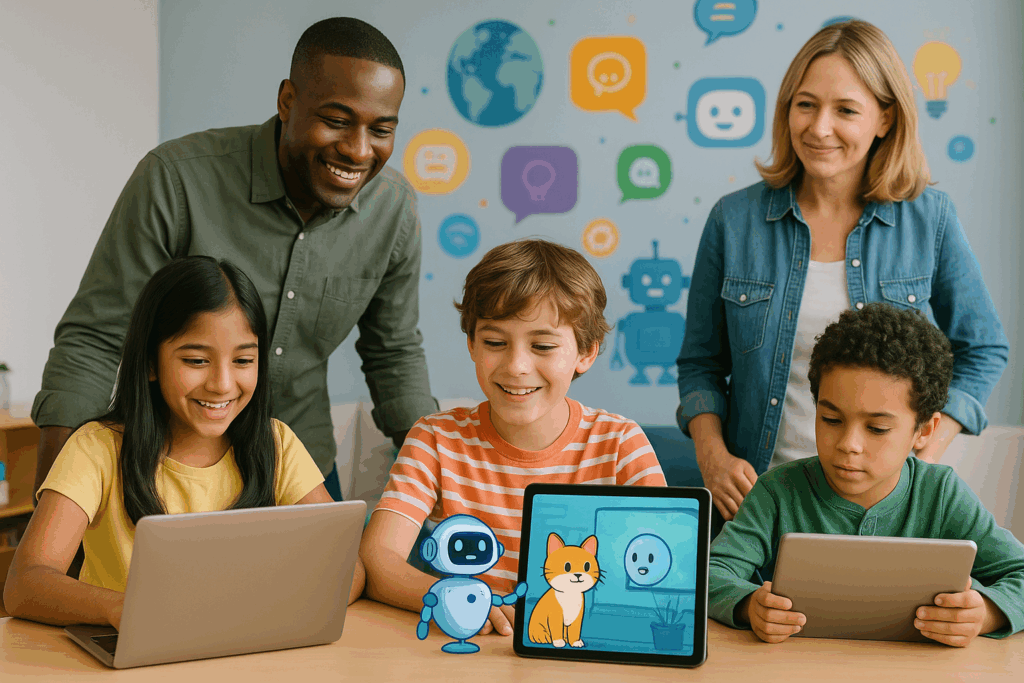New research reveals how children are already using AI tools—and what we adults need to understand about this reality.
The Facts: Children Are Already Using AI
A comprehensive study by the Alan Turing Institute surveyed 780 children aged 8-12 and over 1,000 teachers. The findings might surprise you:
22% of children aged 8-12 have used generative AI tools, with most using them regularly (72% at least once per month). ChatGPT leads the way, used by 58% of children who engage with AI tools.

How Children Use AI
Children aren’t just experimenting—they’re finding genuine value:
- 43% create images and learn new things
- 40% use it for entertainment and exploration
- Different ages, different purposes: 8-year-olds focus on fun, 12-year-olds seek homework help
A Special Finding: Supporting Different Learning Needs
78% of children with additional learning needs use ChatGPT compared to 53% of other children. They use AI significantly more for:
- Communication support (30% vs. 19%)
- Getting advice (39% vs. 16%)
- Social connection (37% vs. 22%)
This suggests AI can genuinely help children who learn differently.
The Equity Reality
Here’s a concerning gap: 52% of private school children use AI tools compared to only 18% of children in state schools. This isn’t just about access—it’s about preparation for a future where AI literacy may be essential.
What Parents Think and Feel
76% of parents whose children use AI feel positive about it. However, nearly all parents share concerns:
- 82% worry about inappropriate content
- 77% worry about inaccurate information
- 76% fear children might trust AI too much
Interestingly, only 41% worry about cheating—much lower than other concerns.
Teachers’ Perspective
Teachers have mixed feelings. While 85% who use AI themselves report increased productivity, they’re more cautious about student use:
- 64% believe AI helps students with additional learning needs
- 49% worry about negative impacts on student engagement
- 57% report students submitting AI-generated work as their own
Children’s Own Concerns
When researchers spoke directly with children, two major themes emerged:
Environmental Impact
Many children were genuinely concerned about AI’s environmental cost. Some chose not to use AI tools after learning about energy and water consumption. Children often care more about environmental issues than adults assume.
Representation Matters
Children of color often felt frustrated when AI tools didn’t create images that represented them. This wasn’t just disappointment—it led them to stop using the tools entirely.
What This Means for Adults
For Parents:
Stay Informed, Not Alarmed
- Ask your children about their AI experiences
- Learn about the tools they’re using
- Discuss both benefits and limitations
Teach Critical Thinking
- Help children question AI outputs
- Explain that AI can make mistakes
- Show them how to verify information
Address the Equity Gap
- Ensure your child has opportunities to learn about AI safely
- Advocate for AI education in schools
- Don’t assume access equals understanding
For Educators:
Embrace the Educational Potential
- Explore how AI can support diverse learning needs
- Develop clear policies about AI use in schoolwork
- Create opportunities for students to learn about AI critically
Focus on AI Literacy
- Teach students what AI can and cannot do
- Discuss bias and limitations
- Help students understand ethical considerations
Bridge the Access Gap
- Ensure all students have exposure to AI concepts
- Provide guidance on responsible use
- Don’t let economic factors determine AI preparation
Practical Steps for Everyone
Create Safe Learning Environments
- Use age-appropriate AI tools when available
- Supervise initial explorations
- Discuss what to do when AI produces concerning content
Encourage Balanced Perspectives
- Acknowledge AI’s benefits while discussing risks
- Help children understand environmental impacts
- Emphasize the value of human creativity and critical thinking
Build Understanding Together
- Learn about AI alongside children
- Share your own questions and concerns
- Make it a family or classroom conversation, not a lecture
The Bigger Picture: Growing Up Digital
This research reminds us that children are growing up in a world where AI is increasingly present. Rather than trying to shield them completely or leaving them to figure it out alone, we need to guide them thoughtfully.
Children bring fresh perspectives to AI—they immediately notice bias, care about environmental impact, and find creative uses adults might miss. Adults bring wisdom, critical thinking skills, and the ability to teach responsible use.
Together, we can help children develop healthy relationships with AI technology.
Moving Forward
The goal isn’t to make children AI experts or to keep them away from AI entirely. It’s to help them become thoughtful users who understand both the potential and the limitations of these powerful tools.
Our role as adults is to provide guidance, not control—and to learn alongside the young people in our lives.
As this technology continues to evolve, the most important thing we can do is stay engaged, stay curious, and keep the conversation going.
How are you approaching AI conversations with the children in your life? What questions are they asking that you hadn’t considered?
#AIEducation #DigitalParenting #ChildDevelopment #AILiteracy #ResponsibleTech